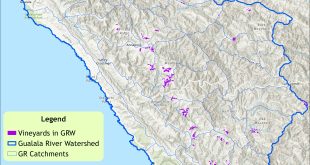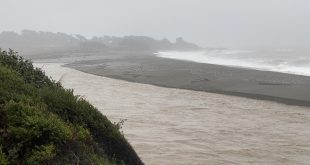| by Chris McManus December 13, 2013 © Independent Coast Observer Reprinted with permission |
Sonoma County Superior Court Judge Elliot Daum has sent a plan to clearcut 154 acres of forest near Annapolis back to the drawing board, saying the Environmental Impact Report prepared by the California Department of Forestry and Fire Protection (Cal Fire) violates the California Environmental Quality Act (CEQA) in several important aspects.
The proposal was made by Artesa Winery to plant a pinot noir vineyard on 154 of the 324 acres in the parcel, removing thousands of trees, including 50- to 75-year-old coast redwoods and Douglas firs, oaks and manzanita bushes.
Artesa’s plan was challenged in court by the Sierra Club’s Redwood Chapter, the Center for Biological Diversity and Friends of the Gualala River.

Friends of the Gualala River used this Chainsaw Wine human sized bottle of Pinot Egregio, shown here with students from Kashia Elementary School, to protest the Artesa proposed forest to vineyard conversion near Annapolis. Chris McManus photo. Reprinted with permission.
“Rather than be destroyed to make room for a vineyard, this redwood forest will continue to do what it does best: provide habitat for wildlife and remove harmful carbon emissions from the atmosphere,” said Justin Augustine, attorney at the Center for Biological Diversity.
Daum’s final ruling, issued last week, largely upheld a tentative ruling he issued in mid-October which sided with the environmental groups on most of the issues they raised. The judge found that, in preparing the environmental review for the project, Cal Fire failed to properly analyze alternatives that would be less damaging to the environment, such as using an unforested area for the vineyard. The court also determined that the agency did not appropriately address the lost carbon sequestration that would result from destroying the forest.
In addition, the court found that the environmental report wrongly ignored California Board of Forestry policy regarding forest conversions. Finally, the court ruled that Cal Fire failed to properly address the project’s pesticide and noise impacts.
This is not the first time Cal Fire has been faulted by the courts over its failure to comply with CEQA, according to Dave Jordan of the Sierra Club.
“To say that Cal Fire has resisted compliance with CEQA over the years is an understatement,” said Paul Carroll, attorney for the environmental groups, when arguing the case to the court. “No California agency has tried as hard to avoid CEQA’s mandates, and none has lost as many times in the courts of appeal. In virtually every published decision in which Cal Fire has argued against CEQA’s application, it has lost.”
Despite the court’s tentative ruling in mid-October, Artesa was still arguing on its website in mid-November that the winery “fights the good fight in Sonoma,” putting a very different spin on its proposal from that articulated by the environmental groups.
“Artesa Winery is fighting to improve and protect a neglected Sonoma, California property in the face of strident opposition from a controversial local group, Friends of the Gualala River,” the website goes on to say.
“Artesa’s proposal was approved by the California Department of Forestry and Fire Protection (CalFire) in 2012 after what official Dennis Hall called, ‘an extreme and exhaustive analysis of potential impacts’ on the surrounding environment,” the website continues.
“Let’s hope reason prevails and that the objections to Artesa preserving this property are successful. The winery and their parent company have done more to enhance and preserve the property than the Friends of the Gualala River ever have.”
Sam Singer, spokesperson for Artesa, did not return the ICO’s calls for comment on the decision. Singer’s website says he is nicknamed “The Fixer,” and boasts that a reporter for the San Francisco Chronicle called him “the kind of crisis manager who can make shoplifting politicians seem sympathetic.”
At least one snapshot of public opinion indicates Artesa is not winning the public relations battle. A senior thesis last year by Monica Dimson of Sonoma State University found that environmentalists, Sonoma County residents in general, residents of the Gualala River watershed and vintners all are opposed to vineyards that clearcut 10 acres or more of continuous forest to plant new vines, although the vintners were less strenuously opposed than the other groups. All the groups except the vintners were neutral to somewhat opposed even to a vineyard that “removes a few scattered redwood or oak trees to plant new vines.”
All the respondents to Dimson’s survey strongly agreed that coastal redwoods and oak woodlands are culturally important to Sonoma County.
Sonoma County 5th District Supervisor Efren Carrillo welcomed the court’s decision Wednesday, contending that the public should have had more opportunity for input before Cal Fire certified the project. “I appreciate the efforts of the local community,” he said. “Friends of the Gualala River have been very involved and their involvement is very welcome.”
Daum’s decision is not the end of the story. Artesa can appeal the decision or go back and, with Cal Fire, correct the deficiencies in the Environmental Impact Report. “It’s up to the applicant,” said Carrillo. The environmental groups are hoping public pressure will convince the winery to abandon the project.
For additional information, see:
Artesa Sonoma forest-to-vineyard conversion
 Cal Fire approved the environmental impact report for Artesa Winery’s controversial plan to clear-cut 154 acres of coastal redwood forest to plant a vineyard in Annapolis, but the report was rejected by the court.
Cal Fire approved the environmental impact report for Artesa Winery’s controversial plan to clear-cut 154 acres of coastal redwood forest to plant a vineyard in Annapolis, but the report was rejected by the court.
 Friends of Gualala River Protecting the Gualala River watershed and the species living within it
Friends of Gualala River Protecting the Gualala River watershed and the species living within it


